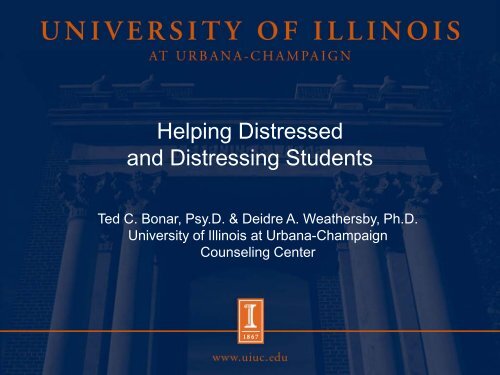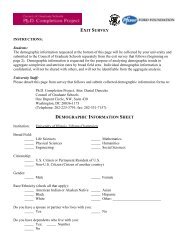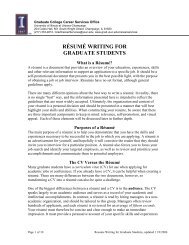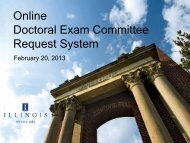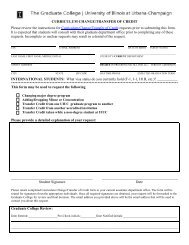Helping Distressed and Distressing Students - The Graduate ...
Helping Distressed and Distressing Students - The Graduate ...
Helping Distressed and Distressing Students - The Graduate ...
You also want an ePaper? Increase the reach of your titles
YUMPU automatically turns print PDFs into web optimized ePapers that Google loves.
<strong>Helping</strong> <strong>Distressed</strong><strong>and</strong> <strong>Distressing</strong> <strong>Students</strong>Ted C. Bonar, Psy.D. & Deidre A. Weathersby, Ph.D.University of Illinois at Urbana-ChampaignCounseling Center
Overview• Mental health concerns among college students– Increased concerns <strong>and</strong> severity– Increased need for services• How to identify distressed students– Common issues• How the community can engage with individualsin distress• What to do when a student is distressing toothers
Goals for the Community1) Identify an individual in distress2) Consult a professional3) Engage the individual or community in asolutiona) How to h<strong>and</strong>le threats/acts of suicideb) How to h<strong>and</strong>le threats to others
College Student Mental Health Concerns• Trends in university counseling centers– Increased dem<strong>and</strong> for services– Increased severity of problems• Depression• Anxiety• Eating concerns• Alcohol/drug use• Attention Deficit – Hyperactivity Disorder (ADHD)• Severe academic distress• Self-harming behavior (e.g. cutting)• Roommate conflict, relationship breakups, identitydevelopment, etc.• Cultural concerns
Depression• What to watch for?• Observable behaviors:– Change in sleep patterns– Change in appetite– Decreased ability to concentrate– Irritability– Poor hygiene– Frequent crying spells– Social isolation– Self-injury– Verbal or written statements of a wish or intent to harmoneself
Anxiety• What to watch for?• Observable behaviors:– Persistent Worrying– Agitation during stressful situations such as exams– Avoidance of social or other situations– One or a combination of physical symptoms:• Rapid breathing• Increased heart rate• Shaking• Sweating• Headaches• Stomach aches• Muscle aches• Sleep difficulty
Eating Disturbance or Concern• What to watch for?• Observable behaviors:– Restricting calorie or food intake– “Over” exercise– Self-induced vomiting– Use of diet pills, amphetamines, laxatives, or diuretics for thepurpose of controlling eating or weight gain– Food rituals– Eating alone/in secret– One or a combination of physical symptoms:• Significant weight loss or gain, swollen gl<strong>and</strong>s, hair loss, puffy cheeks,fainting, dizziness, fatigue, tooth decay
Alcohol, Drugs, <strong>and</strong> Addictive Behaviors• What to watch for?• Observable behaviors:– Disruption in daily functioning due to any mind-altering substance– Attending class or employment while under the influence– Legal difficulties (DUI, drinking tickets)– Overuse of internet/computers for:• Compulsive gambling• Compulsive pornography• Extended gaming (sometimes days at a time)• Social networking– Any of the above that results in neglect or harm to activities ofdaily living (sleep, hygiene, relationships, finances, etc.)
Attention Deficit – Hyperactivity Disorder (ADHD)• What to watch for?• Observable behaviors:– Difficulty managing schedule– Frequent interruptions in class– “Underfunctioning” with life tasks (eating, paying bills, timemanagement, erratic sleep schedule, etc.)– Chronically late assignments– Poor test-taking abilities seemingly incongruent withintelligence– Appearance of “laziness” (excessively playing video games,arriving late to class, etc.) with a stated intention ofcompleting tasks
Cultural Considerations• Under represented student populations• Social environment• Language• Religion• Financial resources/S.E.S.• Gender issues• Sexual orientation concerns• Sexual assault• First-generation college student• Others
General Psychological Distress• Any of the previous signs/symptoms/behaviors• Any behavior representing a dramatic/significantchange from previous lifestyle– Attendance record– Task completion– Life circumstance concerns (recent family death,breakup, etc.)• Trust your instinct– Need to intervene <strong>and</strong>/or consult
Consultation• If a problem is identified, what should you do?• Federal Education Rights <strong>and</strong> Privacy Act(FERPA) allows consultation with mental healthprofessionals when there is a concern about astudent’s well-being
Common Questions• Should I be concerned about my friend/employee/fellowstudent?• How can I get help for someone I know?• I’ve seen someone cutting/vomiting/crying (etc.), but theydon’t want help. What should I do?• I’m nervous about some bizarre emails I’ve been getting,<strong>and</strong> I don’t feel safe. Who can I talk to?• I know someone who told me in confidence about hurtinghim/herself. Can the Counseling Center call them?– What are some other questions?
Engaging <strong>Distressed</strong> <strong>Students</strong>• Keep it simple.– Be clear, concise, <strong>and</strong> direct in your communication.• Hear the problem.– Listening to a person non-judgmentally can be an important part of helping.• Be honest.– It is important to share your concern.• Ask to help.– Invite the student to continue the conversation <strong>and</strong> to ask for help fromothers.• Follow up.– “Continuity of care” is extremely beneficial for all involved: the student, themental health professional, <strong>and</strong> you.
Threatening or Suicidal <strong>Students</strong>• If you sense or underst<strong>and</strong> that there may be danger inapproaching an individual, do not approach.• Unique challenges of distressing students– Managing threats of harm are usually beyond the scope ofmany individuals• Two distinct UIUC programs:– Suicide Prevention Program– Threat Response Protocol
Suicide Prevention Program• Initiated in 1984 through the Counseling Center <strong>and</strong> McKinley HealthCenter• Aims to reduce risk of suicide in the UIUC community• Any individual can notify the Suicide Prevention Team if a student theyknow makes a suicidal threat or gesture– Threats– Attempts– Parasuicide (dangerous self-harming behavior without statedintention of suicide)– A pattern of significant suicide ideation
Suicide Prevention Program (cont.)• What happens? What to do?• Reported student is required to participate in:– Four 1-hour sessions of professional suicide assessment– Assessments conducted by a licensed mental health professional– Anyone can complete a Suicide Incident Report (SIR), availableat:http://www.counselingcenter.uiuc.edu/files/suicideReportForm.pdf
Threats to the Community• UIUC Threat Response Protocol– Designed to address reports of students who have made threats toharm others– Process of setting limits through school administration regardingthreatening behavior
Threats to the Community (cont.)• UIUC Threat Response Protocol – What to do?– If a student is perceived as a threat, do not approach– Seek consultation from:• Supervisors• Campus security• Police• Any mental health professional– <strong>The</strong> Counseling Center can assist in reporting the distressingbehavior– <strong>The</strong> Threat Response Team will then pursue the appropriate action
Underst<strong>and</strong>ing Your Role• You are not expected to be a mental healthprofessional• You are, however, on the front lines• Referral <strong>and</strong> consultation
• Clinical ServicesCounseling Center– Individual Short-Term <strong>The</strong>rapy– Group <strong>The</strong>rapy– Support Groups– Consultation Services– Special Screenings <strong>and</strong> Assessments
• Outreach ServicesCounseling Center– Workshops on request– Tuesday@7 Workshops• www.couns.uiuc.edu/CCP/tuesday7.htm– Inner Voices– Power Reading <strong>and</strong> Study Skills– Program on Intergroup Relations (PIR)– Multicultural/Diversity Liaisons– Interlink– Academic Department Liaisons– Cross-Campus Clinical Committees
Counseling Center• How to refer students for services:– Same day appointments (333-3704)– Call early in the morning (starting at 7:50am)– Student may state concern during phone call– Consultations: state your concerns for student
Emergency Services• Champaign County 24-hour CrisisLine– (217) 359-4141– For use by an individual in immediate distress• UIUC Psychological Emergencies– (217) 244-P911 (acronym: 4-P911 – ForPsychological Emergencies)– For use by faculty, staff, etc. for the purposes ofemergency consultation or reporting an incident
Counseling Center – Online• Self-help brochures– Eating Disturbances– First Generation College <strong>Students</strong>– International <strong>Students</strong> Help Page– Addictive Relationships– Adult Children of Alcoholics– Assertiveness– Perfectionism– Grief <strong>and</strong> Loss– Stress Management– Suicide Prevention• <strong>The</strong>re are dozens of self-help brochures online
Considerations for Employers• Power dynamic between employer-employee– Stigma of receiving mental health assistance/counseling/therapy• Confidentiality– What are the considerations/limits within your unit?– What are the considerations/limits for the university?– What are the considerations/limits of the Counseling Center?– What are the legal <strong>and</strong> ethical requirements?
Counseling Center Mission• Counseling Center values its culturally competent counselors <strong>and</strong> diversestaff• Many cultures may associate mental health services with a sense ofshame, secrecy, or avoidance• <strong>The</strong> Counseling Center has several groups that are “culturally specific”• Some cultures may not utilize or be interested in “traditional” therapypractices as known in our community
Resources for YOU• Consult with a counselor at the Counseling Center about a student:– (217) 333-3704– Student Services Building, 610 E. John St., 2 nd Floor• Mental health resources for your own concerns/self-care:– Employee Assistance Program– Large number of private practitioners in Champaign-Urbana• Counseling Center can provide referrals


